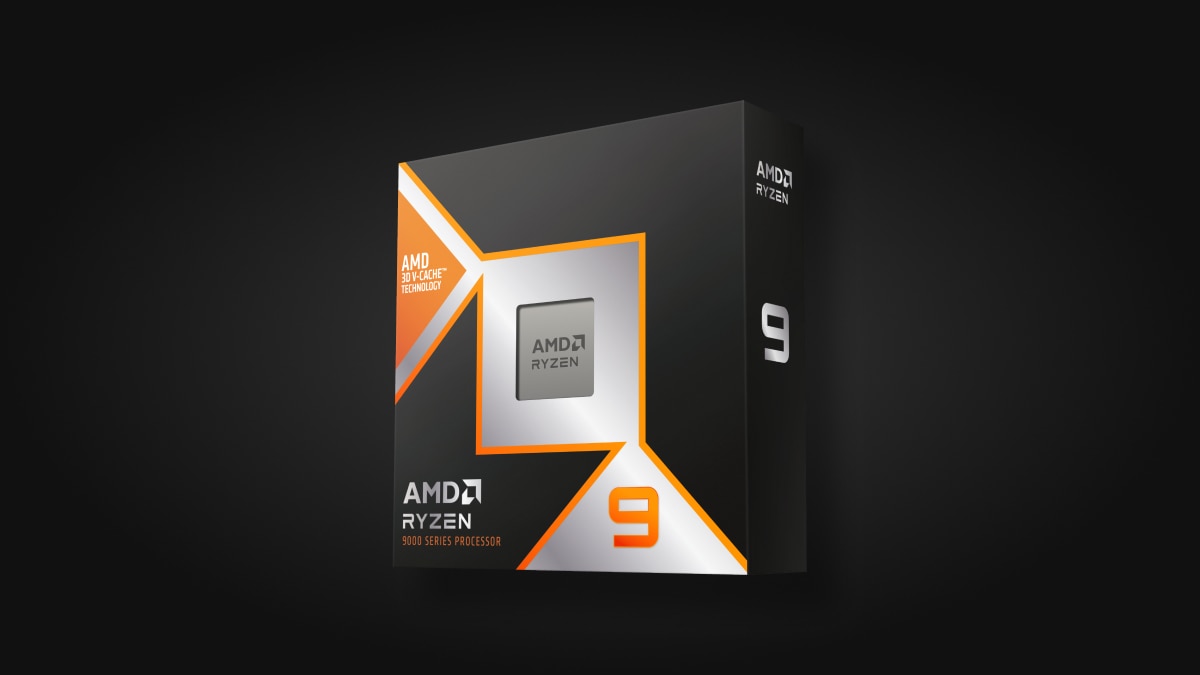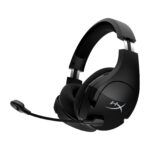AMD’s upcoming Ryzen 9 9950X3D and 9900X3D processors will mark a significant leap in gaming CPU technology and performance. When released, these two CPUs will replace the 9800X3D as the top gaming chips available. The new flagship 16-core Ryzen 9 9950X3D will be priced at $699, while the 12-core 9900X3D will cost $599, with both CPUs launching in March 2025.
Whether you’re a gamer, a content creator, or someone seeking top performance, these processors will provide an attractive option (assuming you can get your hands on one). They combine AMD’s latest Zen 5 architecture with advanced 3D V-Cache technology. The Ryzen 9 9950X3D boasts 16 cores and 32 threads, making it a powerhouse for both gaming and content creation tasks.
AMD claims up to 20% faster gaming performance compared to previous generations, positioning these processors as prime choices for high-end gaming systems. The integration of 3D V-Cache technology specifically targets gaming workloads, reducing memory latency and improving frame rates in modern titles.
Choosing the Right X3D Processor

Release Date
AMD Ryzen 9 9950X3D and 9900X3D are both scheduled to be available in late March 2025.
Pricing
The AMD Ryzen 9 9950X3D will be priced at $699, and the AMD Ryzen 9 9900X3D will be priced at $599.
Specifications:
Ryzen 9 9950X3D:
- Cores/Threads: 16 cores / 32 threads
- Base Clock: 4.3 GHz
- Max Boost Clock: Up to 5.7 GHz
- Total Cache: 144 MB (128 MB L3 + 16 MB L2)
- TDP: 170W
- Architecture: Zen 5
- Socket: AM5
- Memory Support: DDR5
- PCIe Support: PCIe Gen 5
Ryzen 9 9900X3D:
- Cores/Threads: 12 cores / 24 threads
- Base Clock: 4.4 GHz
- Max Boost Clock: Up to 5.5 GHz
- Total Cache: 140 MB (128 MB L3 + 12 MB L2)
- TDP: 120W
- Architecture: Zen 5
- Socket: AM5
- Memory Support: DDR5
- PCIe Support: PCIe Gen 5
AMD Ryzen 9 9950X3D and 9900X3D: A Comparison
AMD’s upcoming Ryzen 9 9950X3D and 9900X3D processors are generating excitement among gamers and PC enthusiasts. These CPUs, successors to the popular 7950X3D and 7900X3D, promise significant performance improvements thanks to AMD’s innovative 3D V-Cache technology. But how do these two processors stack up against each other, and which one is right for you?
Core Count and Performance
The Ryzen 9 9950X3D boasts 16 cores and 32 threads, while the 9900X3D features 12 cores and 24 threads. This difference in core count will likely translate to better performance in heavily multi-threaded applications for the 9950X3D. If you’re a content creator, streamer, or someone who frequently uses demanding software, the 9950X3D might be the better choice. For gamers, the performance difference might be less pronounced, as many games don’t fully utilize a large number of cores.
AMD claims that the Ryzen 9 9950X3D will be approximately 8% faster on average than the previous 7950X3D in gaming, based on benchmarks from 40 games at 1080p. Additionally, it is expected to be 20% faster than Intel’s Core Ultra 9 285K in the same gaming scenarios. In content creation tasks, the 9950X3D is anticipated to be around 13% faster than its predecessor.
3D V-Cache: The Game Changer
Both the 9950X3D and 9900X3D benefit from AMD’s 3D V-Cache technology. This stacked cache significantly increases the amount of L3 cache available to the CPU, leading to improved game performance. The increased cache helps reduce latency and allows the CPU to access frequently used data more quickly. This is particularly beneficial in games that are memory-bandwidth intensive.
This design enhances thermal performance, allowing for higher clock frequencies and improved performance in gaming and content creation tasks.
Clock Speeds and TDP
While exact clock speeds are still subject to confirmation, leaks suggest the 9950X3D will have slightly higher boost clocks than the 9900X3D. Both processors are expected to have a TDP (Thermal Design Power) of around 120W, similar to their predecessors. This means you’ll need a good CPU cooler to keep these chips running at their best.
Pricing and Availability
Pricing is a crucial factor for many buyers. The 9950X3D, being the higher-end model, will naturally be more expensive than the 9900X3D. Official pricing will be announced closer to the release date, which is anticipated to be late March 2025.
Choosing the Right Processor for You
Here’s a quick breakdown to help you decide:
| Feature | Ryzen 9 9950X3D | Ryzen 9 9900X3D |
|---|---|---|
| Cores/Threads | 16/32 | 12/24 |
| Ideal For | Content creation, heavy multitasking, high-end gaming | Gaming, general use |
| Price | Higher | Lower |
If you’re a gamer who also does some content creation or uses demanding applications, the 9950X3D is likely the better choice, provided your budget allows. For gamers on a tighter budget, the 9900X3D offers excellent performance at a more affordable price.
Considering the Alternatives
While the 9950X3D and 9900X3D are exciting, it’s worth considering other options. If you’re not in a rush, you might want to wait for reviews of these processors to get a clearer picture of their performance. Also, Intel’s latest CPUs are worth looking at. They offer strong competition in the high-end desktop market.
Cooling Considerations
High-performance CPUs like the 9950X3D and 9900X3D generate a fair amount of heat. Investing in a high-quality CPU cooler is essential to ensure optimal performance and prevent thermal throttling. A good air cooler or a liquid cooler with a 240mm or 360mm radiator is recommended.
Motherboard Compatibility
The 9950X3D and 9900X3D use the AM5 socket, so you’ll need a compatible motherboard. If you’re upgrading from an older AMD platform, you’ll likely need to purchase a new motherboard as well. Make sure the motherboard you choose has the features you need, such as sufficient M.2 slots, USB ports, and VRM quality.
Gaming Performance and Resolution
The performance difference between the 9950X3D and 9900X3D might be more noticeable at lower resolutions, such as 1080p. At higher resolutions, like 1440p and 4K, the graphics card plays a more significant role, and the CPU performance difference might be less pronounced.
The Role of the GPU
While the CPU is essential for overall system performance, the graphics card plays a crucial role in gaming. If you’re a serious gamer, make sure you have a powerful enough GPU to complement your CPU. A balanced system with a good CPU and GPU will provide the best gaming experience.
Additional Considerations
When building a new PC, consider other factors like storage (SSDs are a must!), power supply, and case. Choosing quality components will ensure a stable and reliable system.
Upgrading Your Existing System
If you’re upgrading from an older system, make sure the new CPU is compatible with your existing motherboard. If not, you’ll need to purchase a new motherboard as well. Also, check if your current power supply is sufficient for the new CPU and other components.
The Value Proposition
The 9950X3D and 9900X3D offer excellent performance for the price. While they’re not the cheapest CPUs on the market, they provide a significant performance boost over previous generations. If you’re looking for a high-end CPU that can handle anything you throw at it, these processors are worth considering.
AMD’s 3D V-Cache Technology: How it Works
AMD’s 3D V-Cache technology is a key feature of the 9950X3D and 9900X3D processors. It involves stacking an additional layer of cache memory on top of the CPU die. This stacked cache significantly increases the amount of L3 cache available to the CPU. The increased cache helps reduce latency and allows the CPU to access frequently used data more quickly.
This is particularly beneficial in games that are memory-bandwidth intensive. In essence, the 3D V-Cache acts as a larger, faster pool of readily accessible data, reducing the need for the CPU to fetch information from slower system memory. This results in improved performance, especially in gaming scenarios. The larger cache can also help with other workloads, such as content creation and scientific simulations, where fast access to data is crucial.
Key Takeaways
- The Ryzen 9 9950X3D and 9900X3D launch in March 2025 with competitive pricing at $699 and $599
- AMD’s new processors deliver up to 20% faster gaming performance through advanced 3D V-Cache technology
- The 16-core flagship model combines gaming optimization with strong content creation capabilities
Technical Specifications and Performance
AMD’s new Ryzen 9 9950X3D arrives with groundbreaking specifications, featuring 16 cores, 32 threads, and an impressive 5.7 GHz boost clock speed. The processor integrates 144MB of total cache and operates at a 170W TDP.
Details of 3D V-Cache Technology
The 9950X3D uses second-generation 3D V-Cache technology, stacking additional L3 cache directly on top of the compute die. This design adds significant cache capacity without increasing the CPU’s physical footprint.
The processor contains 144MB of total cache, with the majority dedicated to L3. This large cache pool reduces memory latency and accelerates data access for applications.
The vertical cache stacking creates shorter data paths compared to traditional horizontal layouts. This architecture leads to faster response times in cache-sensitive workloads like gaming.
Comparison to Previous Generations
The 9950X3D improves upon its predecessor, the 7950X3D, with higher clock speeds and refined cache architecture. Base clock speeds increased from 4.2 GHz to 4.3 GHz, while boost clocks jumped from 5.5 GHz to 5.7 GHz.
Memory support extends to DDR5-5600, providing increased bandwidth over the previous generation’s DDR5-5200 capability.
The new model maintains the same 170W TDP as its predecessor while delivering enhanced performance through architectural improvements.
Gaming and Productivity Benchmarks
Early testing shows 20% faster gaming performance compared to previous models. Games benefit from the expanded cache size and higher clock speeds.
The 16-core design excels in multi-threaded applications:
- Video encoding
- 3D rendering
- Complex simulations
Productivity metrics demonstrate strong single-thread performance improvements:
- 15% faster in CAD applications
- 12% improvement in content creation tools
- 10% better compile times for developers
The combination of high clock speeds and large cache makes the 9950X3D particularly effective for mixed workload scenarios.
Market Impact and Purchase Considerations
AMD’s latest CPU launches signal a significant shift in the high-end processor market, bringing new performance levels and pricing considerations for enthusiasts and professionals.
Pricing and Availability
The Ryzen 9 9950X3D will retail at $699, while the 9900X3D is set at $599 according to early Newegg listings. Both CPUs are expected to hit store shelves by the end of Q1 2025.
Stock availability might be limited at launch due to high demand for these premium processors. Major retailers like Newegg and PCPartPicker will list these CPUs first.
Prices compare favorably to previous generation launches, maintaining similar MSRPs despite performance improvements.
Evaluating Competitors
Intel’s upcoming Arrow Lake processors present the main competition in the high-performance CPU space. AMD’s 3D V-Cache technology gives these new Ryzen chips an edge in gaming performance.
The 16-core 9950X3D stands as AMD’s flagship against Intel’s top offerings. The 12-core 9900X3D targets the mid-high end market segment.
Performance benchmarks suggest AMD holds advantages in gaming while Intel maintains strong content creation capabilities.
Recommendations for Gamers and Creators
The 9950X3D suits enthusiast gaming rigs where maximum frame rates matter. Its enhanced cache design excels in modern games.
Content creators should weigh the 9900X3D against Intel alternatives. The choice depends on specific workload requirements:
- Gaming Focus: Choose 9950X3D for best gaming performance
- Mixed Use: 9900X3D offers good balance of gaming and creation
- Pure Creation: Consider Intel options for certain production tasks
Price-conscious buyers should watch for launch day promotions and bundle deals from major retailers.
Frequently Asked Questions
AMD’s upcoming Ryzen 9 9950X3D and 9900X3D processors bring significant gaming performance improvements and architectural advancements to compete with Intel’s latest offerings.
What are the specifications of the AMD Ryzen 9 9950X3D & 9900X3D processors?
The Ryzen 9 9950X3D and 9900X3D feature AMD’s new Zen 5 architecture.
Both processors incorporate 3D V-Cache technology for enhanced gaming performance.
The CPUs integrate seamlessly with existing AM5 motherboards.
How does the performance of Ryzen 9 9950X3D compare to Intel’s i9-14900K?
AMD’s internal benchmarks show the Ryzen 9 9950X3D performing 20% faster than Intel’s Core Ultra 9 285K across 40 games.
These performance gains demonstrate AMD’s strong position in gaming-focused processors.
What pricing information is available for the Ryzen 9 9950X3D?
The Ryzen 9 9950X3D is listed at $699.
The Ryzen 9 9900X3D comes in at a lower price point of $599.
When will the Ryzen 9 9900X3D be available for purchase?
Both processors will launch in March 2025.
AMD first unveiled these CPUs at CES 2025 in January.
What are the differences between Ryzen 9 9950X3D and the Ryzen 7 9800X3D?
The 9950X3D offers higher core counts compared to the 9800X3D.
The 9950X3D targets enthusiast users seeking maximum gaming performance.
Will the Ryzen 9 9950X3D offer significant improvements over the 7950X3D?
The 9950X3D incorporates the new Zen 5 architecture for improved IPC.
The processor builds upon previous 3D V-Cache implementations with refined thermal characteristics.






